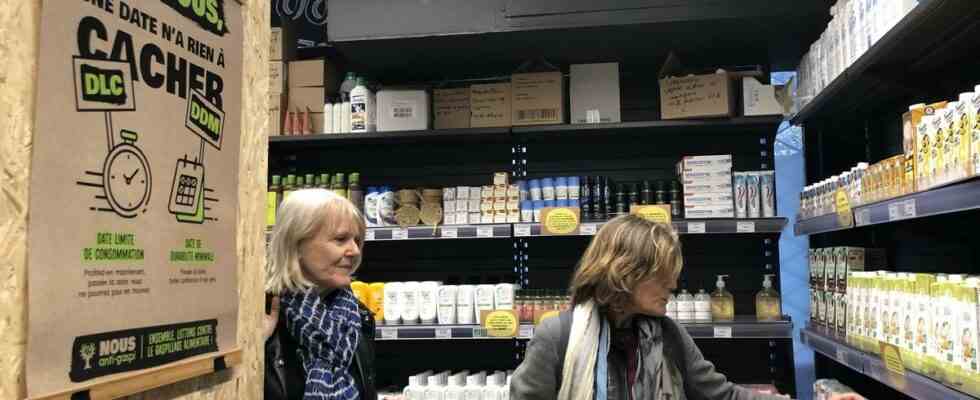Damaged, “non-standard”, mislabelled, short-dated or end-of-series products… In order to reduce waste, stores and anti-waste applications such as NOUS anti-gaspi, Phenix or Too Good To Go buy back discarded products or unsold items from supermarkets and independent businesses to resell them at a lower cost. An advantageous mode of consumption at a time when inflation, which will swell to 3% on food products this year, impacts the wallets of the French a little more every day.
And that’s not counting the bad waste habits. According to figures from the French Environment and Energy Management Agency (ADEME), 10 million tons of consumable food are wasted every year in France. In other words, 30% of products intended for food end up in the trash. If waste begins before the distribution circuit – 54% is wasted by producers and processors – we find 20 kg of food products per year and per inhabitant in household waste.
But who buys anti-waste? And why exactly? 20 minutes slipped into a basket of unsold items to decipher the behavior of these consumers.
“There is no overconsumption”
Once inside the NOUS anti-gaspi store on Avenue Rollin, in the 12th arrondissement of Paris, – one of the 24 present in France –, you quickly realize that it is not a grocery store like the others. “Look at the price of that Knorr soup. I bought it for 1.50 euros more expensive in the supermarket,” rejoices Marie-Amélie, a recent customer. Fresh products, sweet and savory groceries, drinks, bulk products and fruits and vegetables: NOUS anti-gaspi promises them between 20 and 25% less expensive than in the surrounding supermarket chains. “Our customers buy less and less often. Generally, they even come without a shopping list because they know that the arrivals change every week and discover what’s new,” says Véronique Tible, marketing director at NOUS anti-gaspi. On average, the customer comes out with a basket which cost him between 15 and 25 euros, assures the brand.
A nice reduction is also promised by Too Good To Go. The app, which offers baskets of unsold goods from bakeries, restaurants, hotels and supermarkets at “a third of the original price”, according to Lucie Basch, its founder, has even reinvented the habits of certain consumers. “A lot of our users order morning, noon and night,” she says.
Phenix, another application based on a similar model, centered on mass distribution, provides between “- 60 and -70% reduction”, according to Jean Moreau, its co-founder. “Buying cheaper is one of the main motivations of our customers, since 70% of them have a small or medium budget,” he adds. The French start-up announces an average annual saving of 700 euros on shopping. Tempting promises given the context of current food insecurity and inflation. “Consumers come away with a double benefit. There is no overconsumption and they are empowered,” judge Frank Rosenthal, retail expert.
An engaged and guided clientele
And if anti-waste enthusiasts are attracted by the prices, they are of course also attracted by the story behind them. ” A survey we carried out with Ifop in September 2021 indicates that 90% of French people want to adapt their budget to the economic context, but 90% are also sensitive to waste, indicates Vincent Justin, co-founder of NOUS anti-gaspi”. Moreover, all the brands contacted claim a predominantly engaged clientele.
Brands also want to have an educational role. “This is one of the strengths of the stores We anti-waste”, says Frank Rosenthal. Evidenced by the many yellow signs for customers to guide them in the choice of products, their mode of consumption, or simply to tell their story. On the side of Too Good To Go, Lucie Basch recalls that “50% of French people do not know the difference between a use-by date (to be consumed by…) and the date of minimum durability (to be consumed preferably before… )”. “We asked our partners to clarify this difference,” explains the entrepreneur.
What about product defects? It doesn’t seem to put customers off: “They don’t care that the product has undergone a change in recipe, packaging or that the date is short, since it is branded and also effective,” explains Franck Rosenthal. Without forgetting that mass distribution contributes to reinforcing the trend of anti-waste. Since the law of 20 February 2020 on the fight against waste and the circular economy which prohibits throwing away unsold items, “anti-waste rays have flourished everywhere”, continues the expert.
A varied type of clientele
At NOUS anti-gaspi, we come by “opportunity” – the curious – or by “direction” – the regulars -, explains Frank Rosenthal. And the clientele, numbering 1,000 to 3,000 per store per week, is not the same everywhere. “In Paris, it is mainly made up of students and seniors, those with the smallest budgets,” notes Roger Le Roux. On the other hand, in provincial stores, Vincent Justin notices an “overrepresentation of women, often at home, with at least 3 children”.
“Our basic buyer is in fact a buyer, between 25 and 45 years old and rather urban, informs Jean Moreau, from Phenix. Even if 87% of users are outside of Paris”. Students also represent a significant portion of the clientele, around 30%. Lucie Basch observes that “as many men and women, of all ages”, use too Good To Go. “We also receive touching messages from the elderly, who say they can eat their fill thanks to the application,” she rejoices.

